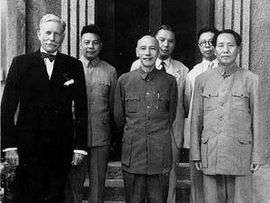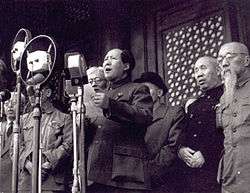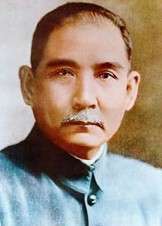Chinese tunic suit


The modern Chinese tunic suit is a style of male attire traditionally known in China as the Zhongshan suit (simplified Chinese: 中山装; traditional Chinese: 中山裝; pinyin: Zhōngshān zhuāng) (after Sun Yat-sen, also romanized as Sun Zhongshan), and later as the Mao suit (after Mao Zedong). Sun Yat-sen introduced the style shortly after the founding of the Republic of China as a form of national dress although with a distinctly political and later governmental implication.
After the end of the Chinese Civil War and the establishment of the People's Republic of China in 1949, such suits came to be worn widely by males and government leaders as a symbol of proletarian unity and an Eastern counterpart to the Western business suit. The name "Mao suit" comes from Chinese leader Mao Zedong's fondness for wearing them in public, so that the garment became closely associated with him and with Chinese communism in general in the Western imagination. Although they fell into disuse among the general public in the 1990s due to increasing Western influences, they are still commonly worn by Chinese leaders during important state ceremonies and functions.[1][2]
In the 1960s and 1970s the Mao suit became fashionable among Western European socialists and intellectuals. It was sometimes worn over a turtleneck.
Origins
When the Republic was founded in 1912, the style of dress worn in China was based on Manchu dress (qipao and changshan), which had been imposed by the Qing Dynasty as a form of social control. The majority-Han Chinese revolutionaries who overthrew the Qing were fueled by failure of the Qing to defend China and science compared to the West. Even before the founding of the Republic, older forms of Chinese dress were becoming unpopular among the elite and led to the development of Chinese dress which combined the changshan and the Western hat to form a new dress. The Zhongshan suit is a similar development which combined Western and Eastern fashions.
The Zhongshan suit was an attempt to cater to contemporary sensibilities without adopting Western styles wholesale. Dr. Sun Yat-sen was personally involved, providing inputs based on his life experience in Japan: the Japanese cadet uniform became a basis of the Zhongshan suit. There were other modifications as well: instead of the three hidden pockets in Western suits, the Zhongshan suit had four outside pockets to adhere to Chinese concepts of balance and symmetry; an inside pocket was also available. Over time, minor stylistic changes developed. The suit originally had seven buttons, later reduced to five.
After repeated attempts to win support and recognition from Western countries failed, the Nationalist Party government in Canton led by Sun gained help (advisers and small arms) from Soviet Russia, which viewed it as a likely revolutionary ally against Western interests in the Far East; Chinese nationalism at the time (of treaty ports and extraterritoriality discriminations) was heavily infected with resentment against the West. As a result of this geopolitical alignment, Sun agreed to permit the nascent Chinese Communist Party to join the Nationalist Party — as individual members — not as a party-party union, combination or alliance. As a result, early Communist Party members adopted the attire as a mark of joining the Nationalist Party. Ironically, from that practice during an attenuated political marriage of convenience which would soon be divorced in blood (in 1927), Asian Marxist movements and governments henceforth would all consider this attire as a standard of political coloration, and it would continue to be appropriate dress for both sides of the bitter Chinese civil wars lasting decades.
After Sun Yat-sen's death in 1925, popular mythology assigned a revolutionary and patriotic significance to the Zhongshan suit. The four pockets were said to represent the Four Virtues cited in the classic Guanzi: Propriety, Justice, Honesty, and Shame. The five center-front buttons were said to represent the five Yuans (branches of government)–legislation, supervision, examination, administration and jurisdiction–cited in the constitution of the Republic of China and the three cuff-buttons to symbolize Sun Yat-sen's Three Principles of the People: Nationalism, Democracy, and People's Livelihood. Finally, unlike Western-style suits that are usually composed of two layers of cloth, the jacket is in a single piece—symbolizing China's unity and peace.
Historical development
In the 1920s and 1930s, civil servants of the Chinese government were required to wear the Zhongshan zhuang. A slightly modified version of the suit, adapted for combat, formed the basis for National Revolutionary Army uniforms leading up through the Second Sino-Japanese War, although during the 1930s, as German military advice and assistance to the National Government waxed, the formal military uniform in the professional elements and ranks essentially became that of Weimar and then Nazi Germany (including the famous helmet).
After the establishment of the People's Republic of China, and especially during the long Maoist era culminating with the Great Proletarian Cultural Revolution from 1966-1976, the suit came to be widely worn by the entire male population as a symbol of proletarian unity; it was regularly worn by Communist Party cadres until the 1990s when it was largely replaced by the Western business suit.
The Mao suit remained the standard formal dress for the first and second generations of PRC leaders such as Deng Xiaoping. During the 1990s, it began to be worn with decreasing frequency by leaders of Jiang Zemin's generation as more and more Chinese politicians began wearing traditional Western-style suits with neckties. Jiang wore it only on special occasions, such as to state dinners. Hu Jintao still wore the Mao suit, but only on special occasions, such as the ceremony marking the 60th anniversary of the People's Republic in 2009.[3] Hu Jintao even showed up to a black tie state dinner in the United States wearing a business suit, attracting some criticism for being underdressed at a formal occasion.[4][5] In the Xi Jinping administration, however, the Mao suit made a comeback as a diplomatic uniform and evening dress.
In Taiwan, the Zhongshan suit was seldom seen after the 1970s. Moreover, given the subtropical weather much of the year in Taiwan, for a time a modified version became at least semi-standard which dropped the high-collar buttoned up original constriction in favor of a Western style open dress shirt collar, unbuttoned.
Symbol of national sovereignty
The Mao suit is worn at the most formal ceremonies as a symbol of national sovereignty. Chinese paramount leaders always wear Mao suits for military parades in Beijing, even though the Vice President and other Politburo officials wear Western business suits. It is customary for Chinese leaders to wear Mao suits when attending state dinners.[6][7][8] In this situation, the Mao suit serves as a form of evening dress, equivalent to a military uniform for a monarch, or a tuxedo for a president.
The Mao suit also serves as a diplomatic uniform. Although Chinese ambassadors usually wear Western business suits, many Chinese ambassadors choose to wear a Mao suit when they present their credentials to the head of state.[9][10][11] The presentation ceremony is symbolic of the diplomatic recognition that exists between the two countries, so it carries a higher level of formality that other diplomatic meetings.
 Chiang Kai-shek inspects Taiwan, 1946
Chiang Kai-shek inspects Taiwan, 1946 Mao at the Tiananmen in 1949
Mao at the Tiananmen in 1949
See also
References
- ↑ http://english.people.com.cn/90001/90776/90785/6775781.html
- ↑ http://www.bbc.com/culture/story/20151007-from-red-guards-to-bond-villains-why-the-mao-suit-endures
- ↑ "Mao suit continued choice of China's top leaders for National Day ceremony", Xinhua, 1 October 2009.
- ↑ Chow, Jason (January 20, 2011). "What to Wear to a State Dinner". Scene Asia. Wall Street Journal.
But Wednesday night, Chinese President Hu Jintao did not wear a tuxedo. Instead, he opted for a dark suit and conservative blue tie. On a sartorial level, the Chinese President was shown up by his American counterpart and the first lady. President Obama wore an elegant dinner jacket; his wife, Michelle, a flowing red dress by Alexander McQueen.
- ↑ Macartney, Jane (January 20, 2011). "Hu's lounge suit was wrong on all counts". The Times (London).
Hu Jintao should have chosen a beautifully cut Mao suit instead of a blue spotted tie for his first White House state dinner.
- ↑ "China State Dinners". The White House Historical Association. Retrieved 30 January 2016.
Presidents Jimmy Carter and Richard Nixon speak with Vice Premier Deng Xiaoping of China during the State Dinner on January 29, 1979.
- ↑ "White House State Dinner for the President of China".
The President and Mrs. Clinton are hosting His Excellency President Jiang Zemin and Madame Wang Yeping at a White House State Dinner on Wednesday, October 29, 1997. President Jiang and Madame Wang will arrive at the North Portico at 7:15 p.m..
- ↑ Ramzy, Austin (March 25, 2014). "A Chinese-Style Suit for Xi Jinping's European Trip". Sinosphere. The New York Times.
President Xi Jinping wore a modified Mao suit to a state dinner hosted by the Dutch royal family in Amsterdam on Saturday, eliciting surprise from Chinese citizens who are used to their leaders’ sartorial decisions being a model of suit-and-tie uniformity.
- ↑ "H.E. Ambassador Zhang Weidong Presents Credentials to the President of Iceland". Embassy of the People's Republic of China in the Republic of Iceland. September 30, 2014.
- ↑ "Ambassador to Sweden Chen Yuming Presents Credentials to His Majesty the King of Sweden". Ministry of Foreign Affairs of the People's Republic of China. December 10, 2013.
- ↑ "Ambassador to Iran Pang Sen Presents Credentials to President Hassan Rouhani of Iran". Ministry of Foreign Affairs of the People's Republic of China. June 23, 2014.
External links
| Wikinews has related news: Mao-style suits fading away in China |
| Wikimedia Commons has media related to Mao suit. |
